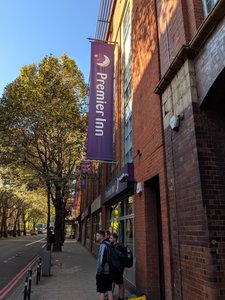Advertisement
Published: November 12th 2019

 20190921_092009
20190921_092009
Premier Inn at Tower Bridge - not close to the bridge!21 September 2019, Saturday
Day 20 on Thames path. Putney Bridge to Greenwich, day 35 of travel
The last day of summer, first day of fall or equinox is today. London promises a sunny 75 degree day.
Tower Bridge to Greenwich
We leave the Premiere Inn at Tower Bridge and walk towards the bridge. As one writer has said, "Tower Bridge is unashamedly Victorian Gothic in style, and inevitably attracted sneers from architectural purists. "However, the public loved the bridge, completed in 1894.
We are still on the South Bank, following the river to Greenwich.
We go along cobbled streets with tall warehouses ahead. We turn down Maggie Blake's Cause, commemorating a recent local activist who fought to allow access to the Thames River Path for everyone, against developers who wanted to restrict it to diners eating at the expensive restaurants, opened in the 1980s, in the old warehouse buildings.
We pass by a replica of a Mississippi paddle steamer. Ahead the river opens up, with boats of all shapes and ages plying their trades are moored alongside the bank.
The Design Museum is on our right, it was once the home of a

 20190921_092408~2
20190921_092408~2
View of Tower Bridge as morning traffic crosses itformer banana warehouse. It houses changing exhibitions reflecting anything modern: cars, furniture, pottery. It is one of those places you see and wish you could pop in and while away an afternoon.
We pass by St. Saviour's Dock. In this area is the long-gone Jacob's Island. In the early 19th century it was one of the most horrible areas of London. Dickens sets the ending of Oliver Twist here, with the evil Bill Sikes trying to escape over the tops of the shanty houses. He dies in the mud of "Folly Ditch." The ditch encircled the island.
Dickens described the slum or rookery as "a place where the buildings on the bank are the dirtiest and the vessels on the river the blackest from the dust of colliers and the smoke of close-built, low roofed houses, there exists the filthiest, the strangest, the most extraordinary of the many localities that are hidden in London."
Cholera in 1849 hit this area hard; the only water supply was the filthy Thames. In the next decade the ditches were filled in and warehouses built.
We leave the river and traipse around an area guarded by high hoardings--a site marked

 20190921_092926
20190921_092926
A nice looking pub, the Anchor Tap, with nice hanging flowersfor part of the new Thames super sewer.
We again return to the river through Fountain Green Square. This square was the former site of Fountain Dock, one of the few dry docks that was to be found in this part of the river and is still seen in 1929 photos. I remember the square quite well for it's strange appearance. There is a scarcity of trees on the green that has little ornamental vegetation. In the center of the green a heavy looking fountain appears as the sole adornment of the square. In contrast the square looks across the Thames and views the beautiful Old Customs House and the Tudor Gothic style Oliver's Wharf.
We continue along the Bermondsley Wall East and arrive at a small plaza containing a family group of statues. And here lies a poignant tale. There is a man sitting on a bench waving his hand at a little girl--her cat is nearby on top of the wall overlooking the Thames.
The man is Dr. Salter, a brilliant physician who dedicated his life to improving living conditions in poverty stricken Bermondsley. There is a fourth statue of his wife and mother of

 20190921_093428
20190921_093428
Our first glimpse of Tower Bridge from the river bankthe little girl. Ada was active in early woman's rights movements and became the first female London Mayor of Bermondsey in 1922.
They had an only child, Joyce, and they decided their family would live in the area, showing more commitment to their beliefs. Joyce died of scarlet fever, an epidemic disease found often in poor areas.
The tableau is a happy one of a father watching his child at play but we know what the ending will be.
The original statue of Salter was stolen in 2011, probably by scrap metal thieves. An area that is still more depressed than many other London areas, the locals felt so strongly about the legendary Dr. Salter that they raised enough money that, with other matching funds from Southwark Council, replaced the statue. What a moving story.
Nearby are foundation remains of King Edward III's moated manor house. It was built in 1353. A very small edifice for a king, some scholars think it might have been a site for the king to work with his falcons. It was a swampy site and a good get-away from his royal duties.
A short detour inland brings us to

 20190921_093319
20190921_093319
The warehouses, now being repurposed for apartments, along the cobble street Rotherhithe Street with its overhead walkways joining buildings, some being old warehouses. Many of the walkways have been turned into aerial gardens.
St. Mary the Virgin Rotherhithe appears. It is a very active Anglican Church and a lynchpin for the surrounding community. There are children in the playground and we find the entrance, open, that is not the usual case. This is a 1715 church built on a medieval foundation, with evidence that a church has existed on this site since 1282. However, when work was being done on the tower in 1913, Roman bricks were found in the site. This site has been used for many, many years. English Maritime history is linked with this church.
For Americans this is a special church--this is the location from which the Mayflower sailed in 1620 with Puritans as cargo. Three owners of the ship are buried here as is the captain. Interestingly a prince, Lee Boo, is also buried here--another story for another time.
An elderly man is standing guard duty and happily answers questions. I would say this is a high-church of England. The members reject the ordination of women. By looking at bulletins and newsletters one

 20190921_093805
20190921_093805
Paddle wheel river boat on the Thamescan ascertain ritual and traditions are important. Intrinsically it is a conservative church. It is peaceful to watch the dust motes in the air, illuminated by light coming in through the windows--there is incense in the air.
The 1703 charity school house faces the church. Figures of children dressed in uniform are above the door.
We continue around a large bend in the river
and up ahead are the glass skyscrapers of Canary Wharf across the Thames on the north bank. Ahh, what a transformation story! Perhaps some of you have watched episodes of the BBC serial, "Call the Midwife." The action takes place in an area called Poplar East London, home to the large West and East India dock sites, sited near Canary Wharf. From the 1600's Poplar has provided homes for dock workers and was one of London's first multi-ethnic neighborhoods. It was an area rife with poverty.
Now it's neighbor, Canary Wharf, has experienced a Cinderella change and from the abandoned and dreary docklands, closed in the 70s, it is now a land of investment banks, one skyscraper after another, shopping areas and trendy restaurants.
Meanwhile, taking our eyes off the glitz across

 20190921_095644
20190921_095644
The hoardings of the super sewer project of Londonthe river, we come to Surrey Docks Farm. It is a working city community farm and boasts produce gardens and animals. It is an educational enterprise, sitting on 2.2 acres. A couple we have met on the walk have suggested the farm's cafe for lunch, but, sadly, it is closed.
Now hungry, we pass Greenland Pier that opens into South Dock, the oldest riverside wet dock in London. It was laid out in the end of the 17th c. It is a survivor from the 1970's dock closures when most of the docks were filled in.
We now enter sad Deptford, a district that has not fared well. From the mid-16th c. to late 18th c. the Royal Navy Dockyard was located here. The Tudor dockyard was started by Henry VIII. He decided he would have a Royal Navy that would gain supremacy on the seas and that meant a good dockyard that could build and repair shops. He could keep an eye on operations from his palace in nearby Greenwich.
But as time went by the ships became larger and the river silted up. The dockyard closed in 1869. The Navy Victualling Yard was based here

 20190921_095900
20190921_095900
This fence is part alive and part painted plants from 1788 to 1961. At one time it was the largest food processing business in Britain. It manufactured mustard and pepper, chocolate, biscuits and managed supplies of rum, tobacco, clothing and medical supplies.
We are now hurrying along--tired and hungry. It is certainly not a beautiful or interesting area. The couple who had suggested the Surrey Dock Farm for lunch had told us to 'get through' Deptford and not tarry.
As directed we cut diagonally across Pepys Park. One wonders why the famed diarist would be around these parts----were these dockworkers particularly interested in English literature? But then I read Pepys had served as clerk to the Navy Board and was familiar with the dockyard.
After we exit the park and pass through a housing estate, we enter Sayes Court Park. We pause to rest at an exit opening and a lovely metal gate is in sight. Upon closer examination one sees the fine details are quite rusty and in need of repair.
In the late 17th c. John Evelyn, the famed diarist, built a most lovely garden and summer home here. The gardens were full of botanical wonders, there were 300 fruit trees and a

 20190921_095737
20190921_095737
Descriptions about the sewer projectbeautiful lake. Little is left of this sliver of the once glorious estate. Its demise was hastened when young Peter the Great came to the dockyards area to learn about shipbuilding. He leased the estate for three months. Supposedly he learned more about the local pubs than maritime subjects. His carousing entourage destroyed the house and gardens and they never regained their former glory.
One vestige of the garden's fame is a mulberry tree, over 300 years old. Beautiful plane trees shade the little pocket of green.
We are nearing the day's destination, Greenwich, but first we pass little Twinkle Park. A bright spot in a melancholy landscape.
We pass by Convoys Wharf, 40 acres of land next to the desirable environs of Greenwich. For years groups of concerned citizens, such as "Deptford Is" have been battling government and developers over the future of this old wharf area. As one local put it, "We don't want Dubai on the Lower Thames."
Looking up ahead we see the Cutty Sark, a many-masted tea clipper built in 1869. We immediately hit the main Street of Greenwich and have a delicious meal at the Buffalo American Grill and Tex

 20190921_100720
20190921_100720
A pretty park we passed through on the river bank.Mex. Jo thinks they have the best calamari!
A few doors down we settle in for several nights at The Mitre Inn. What a day and it is not over yet. Harlan and Jo catch an Uber, after waiting for a taxi, in vain, that comes many minutes after it was supposed to?, and return to the Premium Inn where they have held our luggage for the day. The end is in sight!
.
Advertisement
Tot: 0.051s; Tpl: 0.014s; cc: 7; qc: 23; dbt: 0.028s; 1; m:domysql w:travelblog (10.17.0.13); sld: 1;
; mem: 1.1mb





















